mysteriusbhoice
Hazard to Others
  
Posts: 475
Registered: 27-1-2016
Member Is Offline
Mood: Became chemistry catboy Vtuber Nyaa
|
|
Strange Copper 2 chlorate + sodium chlorate complex
So, I was trying to explore the possibility of decomposing sodium chlorate by the use of copper 2 chlorate in this reaction.
Cu(ClO3)2 = CuCl2 + O2 (73 Celsius)
CuCl2 + NaClO3 = NaCl + Cu(ClO3)2
I tried doing this in solution and it just evaporated down then I Obtained a small sample of the green crystals and tried decomposing the crystals at
around 100 Celsius but even at 140 it only begun to turn brown then Cl2 gases started evolving and eventually black copper oxide formed and hence the
loss of Cl2 gas makes this reaction not possible.
This was in hopes to use for catalytic removal of NaClO3 from NaClO4 mixture.
So I called it a day and went to bed and left the green crystals outside in the humid room.
The next day the crystals have not taken up water and seem to no longer be hygroscopic and usually NaClO3 would be left as a puddle of water by then
and even after 2 days its still not a wet puddle.
So I then tried this with KClO3 salt and dripping Cu(ClO3)2 into it and it suddenly turned green so I then evaporated it off on the stove using a
glass pan in a sand pot and obtained some nice greenish powder.
My question is, what is this strange green salt because Cu(ClO3)2 is blue colored crystals and why does mixing 2 very hygroscopic salts of chlorate
create a product which is non hygroscopic.
Pics below.
far left is NaClO3 + Cu(ClO3)2
middle is KClO3 + Cu(ClO3)2
right is NaClO3 with some droplets of NaClO3 solution on walls.
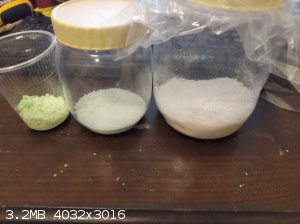
[Edited on 15-7-2020 by mysteriusbhoice]
|
|
|
Bedlasky
International Hazard
    
Posts: 1219
Registered: 15-4-2019
Location: Period 5, group 6
Member Is Offline
Mood: Volatile
|
|
Green colour can be caused by presence of chloride anions.
Btw. MnO2 is used for catalytic decomposition of chlorates in to oxygen and chlorides. But maybe MnO2 also cause decomposition of perchlorate too, I
don't know.
|
|
|
mysteriusbhoice
Hazard to Others
  
Posts: 475
Registered: 27-1-2016
Member Is Offline
Mood: Became chemistry catboy Vtuber Nyaa
|
|
so maybe my reaction does work but its slow.
since I know copper perchlorate is more stable and the plan is to then ammoniate that and decompose with hot water to form NH4ClO4 as seen in
liptakov's video.
The MnO2 thing doesnt happen in aqeuous solutions or at low enough temps.
I need something that can happen either way where it will decompose all chlorate but not touch perchlorates.
That green color tho happened instantly as I added sodium chlorate + copper chlorate at room temp so thats what confused me...
[Edited on 15-7-2020 by mysteriusbhoice]
|
|
|
woelen
Super Administrator
        
Posts: 7977
Registered: 20-8-2005
Location: Netherlands
Member Is Offline
Mood: interested
|
|
Do you really have Cu(ClO3)2? Could you make pictures of the original reagents, before you mix them?
I hardly believe that if you had Cu(ClO3)2 that it cleanly decomposes to CuCl2 and O2. I'm quite sure that on heating, this salt would decompose to
CuO or some basic chloride. If you have Cu(ClO3)2, then it will be a hydrated salt, Cu(ClO3)2.nH2O (I don't know the value of n, but it certainly is
not equal to 0). Such hydrated salts almost always decompose to the acid and the oxide on heating. In the case of chloric acid, there will be further
decomposition to Cl2, O2, HCl and water.
In general, mixing hygroscopic compounds can perfectly lead to formation of much less hygroscopic compounds. The mix may form a so-called double-salt.
Such a double-salt still has the same ions as the original salts, but arranged in a different crystal lattice (hence, it is not a coordination
complex). The other arrangement may make it much more difficult for water molecules to be trapped in/to adhere to the lattice and then you have a much
less hygroscopic compound. A nice example is so-called chlorine chalk. CaCl2 is very hygroscopic, it is a drying agent. Ca(ClO)2 also is hygroscopic.
It becomes wet on standing in humid air. But if you mix the two in a molar ratio of 1 : 1 and allow the solution of this to crystallize again, then
you get a salt Ca(OCl)Cl, a mixed chloride/hypochlorite. This material is a dry free flowing powder. In the past you could buy this as bleach chalk or
chlorine chalk. Nowadays, this hardly is made anymore and its use has been replaced by the use of Ca(ClO)2 or organic stuff like TCCA or Na-DCCA.
|
|
|
mysteriusbhoice
Hazard to Others
  
Posts: 475
Registered: 27-1-2016
Member Is Offline
Mood: Became chemistry catboy Vtuber Nyaa
|
|
Quote: Originally posted by woelen  | Do you really have Cu(ClO3)2? Could you make pictures of the original reagents, before you mix them?
I hardly believe that if you had Cu(ClO3)2 that it cleanly decomposes to CuCl2 and O2. I'm quite sure that on heating, this salt would decompose to
CuO or some basic chloride. If you have Cu(ClO3)2, then it will be a hydrated salt, Cu(ClO3)2.nH2O (I don't know the value of n, but it certainly is
not equal to 0). Such hydrated salts almost always decompose to the acid and the oxide on heating. In the case of chloric acid, there will be further
decomposition to Cl2, O2, HCl and water.
In general, mixing hygroscopic compounds can perfectly lead to formation of much less hygroscopic compounds. The mix may form a so-called double-salt.
Such a double-salt still has the same ions as the original salts, but arranged in a different crystal lattice (hence, it is not a coordination
complex). The other arrangement may make it much more difficult for water molecules to be trapped in/to adhere to the lattice and then you have a much
less hygroscopic compound. A nice example is so-called chlorine chalk. CaCl2 is very hygroscopic, it is a drying agent. Ca(ClO)2 also is hygroscopic.
It becomes wet on standing in humid air. But if you mix the two in a molar ratio of 1 : 1 and allow the solution of this to crystallize again, then
you get a salt Ca(OCl)Cl, a mixed chloride/hypochlorite. This material is a dry free flowing powder. In the past you could buy this as bleach chalk or
chlorine chalk. Nowadays, this hardly is made anymore and its use has been replaced by the use of Ca(ClO)2 or organic stuff like TCCA or Na-DCCA.
|
I have pics of my copper chlorate which I make in a porous pot cell which produces a dark blue color instead of dark green (CuCl2) and yes I have done
this to make CuCl2 which looks way different as that solution is only green and never blue.
I also heated this double salt on the stove and it doesnt appear to have decomposed because when heated to 140 only then does it decompose into CuO
and NaCl releasing Cl2 gases due to decomposition of Cu(ClO3)2 which has an obvious smell.
The color isnt done justice due to camera in reality its a much deeper blue sort of like staring into moderately deep sea water.
.
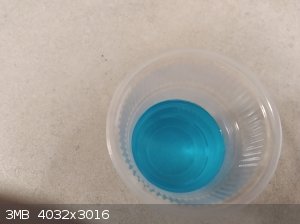 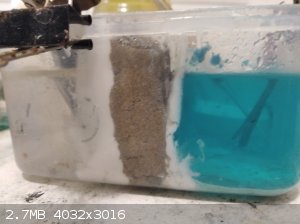
[Edited on 16-7-2020 by mysteriusbhoice]
|
|
|
mysteriusbhoice
Hazard to Others
  
Posts: 475
Registered: 27-1-2016
Member Is Offline
Mood: Became chemistry catboy Vtuber Nyaa
|
|
I also am doing a CuCl2 run just to compare the 2 solutions and right off the bat its already looking different.
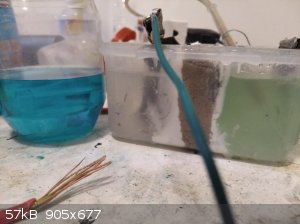
edit: I added the chloride when the run finished for comparison below.
I would really say that copper chlorate/perchlorate by electrolysis, seems viable and no need to deal with chloric/perchloric acid with chloric being
annoying to make without ending up with sad yellow mess.
The loss of chlorine on the decomposition makes using it non viable for any sort of catalytic decomposition atleast in standard pressure.
Maybe high pressure and that chlorine wont escape and can react to form chlorides when CuO interacts with the produced chlorine.
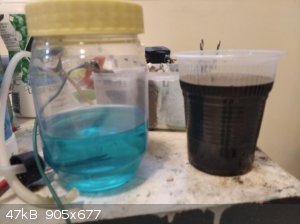
[Edited on 17-7-2020 by mysteriusbhoice]
|
|
|
woelen
Super Administrator
        
Posts: 7977
Registered: 20-8-2005
Location: Netherlands
Member Is Offline
Mood: interested
|
|
It still is not clear to me how you make the Cu(ClO3)2. Could you provide a step by step description on how you made Cu(ClO3)2 ?
|
|
|
mysteriusbhoice
Hazard to Others
  
Posts: 475
Registered: 27-1-2016
Member Is Offline
Mood: Became chemistry catboy Vtuber Nyaa
|
|
STEPS:
1. I used a porous cell in which the barrier is constructed using sand + PVC cement which allows water and ions to pass.
2. The cell was then treated with one side soaked in HCl and second soaked in NaOH to allow current to flow on initial run.
3. the cell contents were thrown out and cell was washed well on both sides.
4. electrodes are copper(+ve) and stainless steel (-ve) and an air pump hooked up to a small dropper provides agitation on the anode side.
4.1 The supply is a computer power supply with 12v supply voltage.
5. The solution in the anode side is a conc NaClO3 solution but not saturated around 50g/100ml with a few drops of HCl to act as a jumpstart to
prevent formation of insoluble copper precipitate and the cathode side has just a pinch of NaClO3 just to provide conductivity as the Na ions migrate
to the cathode side and copper replaces them.
5.1. the cell was let to run for several hours with an ampmeter to check current flow and since my pH meter is dead for now im using strips to monitor
the pH of the cathode side and anode side.
6. the pH of the cathode side climbs till its about 11 and then the cathode side contents are dumped using a siphon and replaced with fresh solution
with pinch of NaClO3.
6.1 Removal of NaOH from cathode side is necessary or else Na IONs wont wanna migrate due to osmosis which counteracts the main driving force of this
setup.
7. after some time the current reduces and eventually you will have copper migrating to the cathode side which marks the end of the run and if you
used stainless steel you will see it turning brown.
8. note that false positives can occur especially when u just switched the solution of the cathode side.
on another note.
The same can be done to make copper chloride/copper sulfate/whatever and if you use sodium sulfate to produce copper sulfate that can be a way to
produce H2SO4 by plating out the copper and re running and works if you have a hard time accesing it.
This cell is very versatile and right now im trying to make iron trichlorate using it.
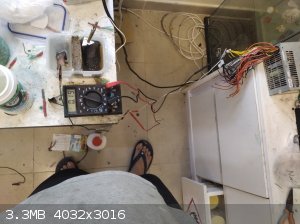
|
|
|
mysteriusbhoice
Hazard to Others
  
Posts: 475
Registered: 27-1-2016
Member Is Offline
Mood: Became chemistry catboy Vtuber Nyaa
|
|
id even say the perchlorate version of this double salt which can be safely boiled down without decomposing but be sure to take the heat down when you
get to the slurry stage or you may gas yourself with chlorine and be left with a sad black mess.
The idea now is to pass ammonia gas through this dry double salt to produce TACC or even TACP and right now I currently have urea + NaOH to help me do
just that but I wonder if thats a safe idea or will it lead to an explosion prolly best to cool it down just incase and work with small amounts and
yes I have one where its mostly copper chlorate but this salt is hygroscopic but still less so that NaClO3 or Cu(ClO3) as for its exact ratio I have
no clue since heating Cu(ClO3)2 solution probably wont be a good idea overall I just mixed my end solution around 100 ml and about 20 grams of NaClO3
instead of adding tiny amounts of my end solution into NaClO3.
I dub this salt Shrek green.
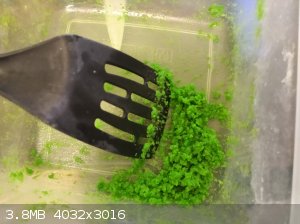
|
|
|
mysteriusbhoice
Hazard to Others
  
Posts: 475
Registered: 27-1-2016
Member Is Offline
Mood: Became chemistry catboy Vtuber Nyaa
|
|
after adding 30% a bit of ammonia solutionto the double salt till it all dissolved and heating to about 70 Celsius I got a sky blue powder which
when heated just decomposed BUT when confined and hammered it detonates and left my ears ringing for 2 mins during that first test.
Now im going to wear hearing protection whenever working with it.
I call it TACC-DS
and I have a video showing it which is linked below.
It seems to have a bit of oxidizing properties but not much and seems stable enough to be heated to quite the high temp before it starts turning green
back to the double salt.
A binder or plasticizer would be perfect for it since its OB+ assuming its stable after a week or more.
edit:
yes I wore earplugs when doing this and it was still loud!
when confined and heated it also fizzles and really only detonates on shock and quite insensetive too, but once it goes oh man!!
when added to hot boiling water in dillute quantities it seems to fall apart and CuO and Ammonium CHLORATE seems to form.
https://youtu.be/eEaNpzh1hFg
[Edited on 18-7-2020 by mysteriusbhoice]
|
|
|
Diachrynic
Hazard to Others
  
Posts: 219
Registered: 23-9-2017
Location: western spiral arm of the galaxy
Member Is Offline
Mood: zenosyne
|
|
This shock vs. flame behaviour is reminiscent of ammonium chlorate. Heat it and it only burns, and not even that well. Hitting it is another story and
makes it detonate.
Overall this just seems like very impure TACC however.
The color of copper chlorate isn't very consistent but it seems the pure tetrahydrate is blue, while heating it transforms it into a green basic salt.
The decomposition temperature varies a lot in the literature as well.
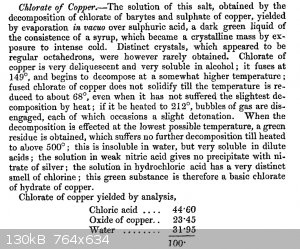
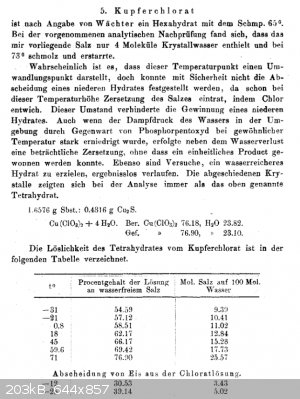

Do you think this "double-salt" (does it actually form one crystal together or is it just sodium chlorate through which copper chlorate is dispersed?)
could be made from mixing sodium chlorate and copper chlorate solutions made separately? It would also be good to determine the actual copper
concentration inside this mixture.
we apologize for the inconvenience
|
|
|
woelen
Super Administrator
        
Posts: 7977
Registered: 20-8-2005
Location: Netherlands
Member Is Offline
Mood: interested
|
|
@mysteriusbhoice: Thanks for writing all the steps. I now indeed am convinced that you made copper chlorate in your solution. Purity of the product
will be hard to assess, but I think it is sufficiently pure for basic experiments. Getting it totally free of Na(+) ions will be very hard. At
increasing copper concentration increasing amounts of copper ions will migrate to the cathode area, together with sodium ions. But now that I
understand what you have done, it becomes much more interesting to read about it 
|
|
|
mysteriusbhoice
Hazard to Others
  
Posts: 475
Registered: 27-1-2016
Member Is Offline
Mood: Became chemistry catboy Vtuber Nyaa
|
|
Quote: Originally posted by Diachrynic  | This shock vs. flame behaviour is reminiscent of ammonium chlorate. Heat it and it only burns, and not even that well. Hitting it is another story and
makes it detonate.
Overall this just seems like very impure TACC however.
The color of copper chlorate isn't very consistent but it seems the pure tetrahydrate is blue, while heating it transforms it into a green basic salt.
The decomposition temperature varies a lot in the literature as well.
Do you think this "double-salt" (does it actually form one crystal together or is it just sodium chlorate through which copper chlorate is dispersed?)
could be made from mixing sodium chlorate and copper chlorate solutions made separately? It would also be good to determine the actual copper
concentration inside this mixture. |
The thing is that when I mixed the deep blue solution of copper chlorate with solid sodium chlorate at room temp it immidiately turned green and made
a green solution when completely dissolved with zero decomposition or gas emission.
The green solid here is obtained testing both ways where 1 is by boiling solution and letting it cake and slow evaporation and both obtained an
identical green salt that is not hygroscopic though that seems to depend on concentration of the 2 chlorates where if you have higher ammount of
copper chlorate like that deeper green salt then it wont totally absorb humidity and become a puddle but will always be damp solid when left out.
The fact that it somehow removes the hygroscopic properties of the chlorate means its doing something and also when heated and mixed with sugars both
salts show strong oxidizing properties and when heated without a fuel the salt turns into this black puddle which is probably sodium chlorate + CuO
and Cl2 is released as it turns black.
The impure TACC is also pretty funny because that product is not hygroscopic at all and is even more stable except when hit and when comparing with
explosions and fire's video on ammonium chlorate and also making some ammonium chlorate for fun previously this stuff seems more powerful! and right
now I will let it sit for a week and if its ammonium chlorate or contains it then like my other sample it should become completely inert or weaker
after that time.
EDIT:
after 24 hours the impure TACC is still sky blue and still detonates with the same ferocity and both TACC and ammonium chlorate usually decompose by
then.
[Edited on 19-7-2020 by mysteriusbhoice]
|
|
|
mysteriusbhoice
Hazard to Others
  
Posts: 475
Registered: 27-1-2016
Member Is Offline
Mood: Became chemistry catboy Vtuber Nyaa
|
|
Quote: Originally posted by woelen  | @mysteriusbhoice: Thanks for writing all the steps. I now indeed am convinced that you made copper chlorate in your solution. Purity of the product
will be hard to assess, but I think it is sufficiently pure for basic experiments. Getting it totally free of Na(+) ions will be very hard. At
increasing copper concentration increasing amounts of copper ions will migrate to the cathode area, together with sodium ions. But now that I
understand what you have done, it becomes much more interesting to read about it 
|
I was also able to make Iron Trichlorate which precipitates out as a brown solid and looks like rust but is a bit lighter in color.
it is however different because when heated it also decomposes into Cl2 + O2 and reaks pretty bad turning into a red powder Fe2O3 and when mixed with
a fuel burns bright orangey yellow and turns into a black colored powder.
I however think its possible to seperate rust and iron trichlorate by reacting the rust with an acid but I have no clue which acid can safely react
with the iron oxide my first guess would be acetic acid but adding organic acids to an unstable chlorate may cause it to decompose in solution.
|
|
|
mysteriusbhoice
Hazard to Others
  
Posts: 475
Registered: 27-1-2016
Member Is Offline
Mood: Became chemistry catboy Vtuber Nyaa
|
|
I think using KClO3 instead of NaClO3 will probably make better quality copper chlorate since you can evaporate and add alcohol/freeze to the solution
to remove most of the potassium chlorate remaining.
Will have to do that test later and since KClO3 is much less soluble and Cu(ClO3)2 is much more soluble then it will be easy to know the endpoint when
no more KClO3 is in the anode side of the cell.
|
|
|
woelen
Super Administrator
        
Posts: 7977
Registered: 20-8-2005
Location: Netherlands
Member Is Offline
Mood: interested
|
|
The lower solubility of KClO3 also makes it harder to get a decent current. So, there is a trade off between efficiency and purity, which can be
achieved. Interesting to see the results. it is interesting to see what can be done with such a cell as you constructed.
Getting solid crystalline copper chlorate hydrate would be really cool. I do not think it is an article of commerce. Copper perchlorate is available
commercially (albeit at high cost), but copper chlorate most likely is not.
|
|
|
mysteriusbhoice
Hazard to Others
  
Posts: 475
Registered: 27-1-2016
Member Is Offline
Mood: Became chemistry catboy Vtuber Nyaa
|
|
A hot water bath could make it so KClO3 can be used for such a cell.
edit:
I think I have found a way to get pretty pure copper chlorate.
the basic hydrate of copper chlorate mentioned in the paper above seems to be what I get when I dont add HCl to the cell and is a off green color.
filtering that and adding HCl to convert it into acid will result in a product free from Na Ions.
Also made some TACP by running my NA perchlorate in membrane cell then ammoniating.
Unlike TACC it can be seperated out by freezing and is stable and next time imma also add some hexamine to make CHP.
edit2:
TACC-DS is more stable than the TACP WTF!! and even after 3 days it still detonates when hit meaning its really its own thing and not just ammonium
chlorate + copper chlorate but TACC-DS is slightly hygroscopic because when humidity went up it got became damp and it getting wet caused some of it
to decompose (turning green) but most of it is still sky blue.
at temp of 25 Celsius for 3 days and still have the same power and ferrocity this TACC-DS really doesnt seem like just impure TACC with ammonium
chlorate.
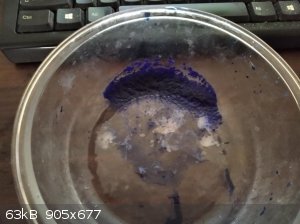
[Edited on 20-7-2020 by mysteriusbhoice]
|
|
|